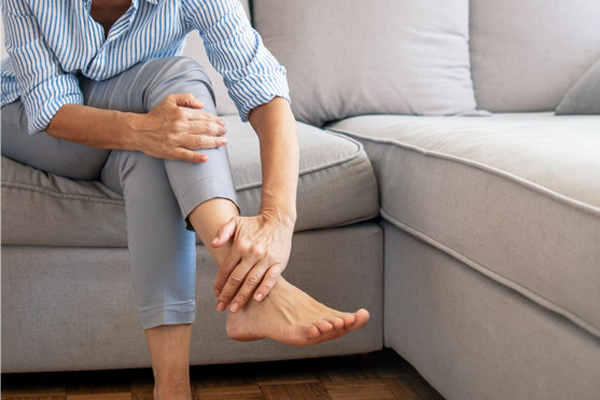Anatomy of the Ankle Joints
Your ankles are hinged synovial joints that connect your lower leg to your foot. As synovial joints, your ankles are surrounded by a thin layer of fluid-filled tissue called the synovium, which helps lubricate the joints and reduce friction. In addition to the synovium, the ankle joints are composed of various intricate structures, including:
Ankle Bones
The ankle joint is made of three bones:
- Tibia: shinbone, the larger bone in the lower leg
- Fibula: calf bone, the smaller bone in the lower leg
- Talus: small bone that connects the ankle to the leg
Ankle Ligaments
The bones in the ankles are connected by ligaments, which are tough bands of tissue that connect bones to other bones. These structures act as stabilizers and keep the ankle in place. There are several major ligaments in the ankle, such as:- Anterior talofibular ligament (ATFL): connects the front of the talus to the fibula
- Calcaneofibular ligament (CFL): connects the heel bone to the fibula
- Posterior talofibular ligament (PTFL): connects the back of the talus to the fibula
- Anterior inferior tibiofibular ligament (AITFL): connects the tibia to the fibula
- Deltoid ligaments: support the entire inner section of the ankle
Ankle Tendons
Tendons are connective tissues that attach muscles to the ankle’s bones, providing the ankle with its extensive range of motion. There are three prominent tendons in the ankle:- Achilles tendon: located at the back of the ankle, connecting the calf muscles to the heel bone. It is the strongest tendon in the body and helps raise the heel when walking or running.
- Peroneal tendon: a set of tendons situated on the outside of the ankle, attaching the muscles of the lower leg to the bones of the foot and allowing the foot to turn outwards.
- Posterior tibial tendon: connects calf muscles to the underside of the foot, helping to support the arch and allowing the foot to turn inwards.
Most Common Injuries to the Ankle Joints
Ankle joints are highly susceptible to injury because they support your entire body weight and bear the force of impact when you stand, run or jump. Absorbing such an impact can place significant stress on the ankle’s ligaments, muscles and bones, which can lead to various injuries. Among the most common ankle injuries are:
Ankle Sprains
An ankle sprain occurs when the ligaments that support the joints are stretched beyond their limits or are torn. They are the most common type of ankle injury and can happen if you twist or roll your ankle, frequently occurring in sports like basketball, soccer and volleyball. Ankle sprains can be classified in three ways:
- Grade 1: least severe sprain, when the ligaments have overstretched without tearing
- Grade 2: when the ligaments have overstretched, leading to partial tearing of one or more of them
- Grade 3: most severe ankle sprain, when all the ligaments have fully torn
Ankle Fractures
Ankle fractures occur when one of the bones in the ankle breaks. They are less common than sprains, but they can be more serious. Fractures can occur if you fall and land on your ankle joint or if you have a direct impact to the bone. Both sprains and fractures can lead to:- Significant pain
- Limited range of motion
- Difficulty or inability to place weight on the affected ankle
- Bruising and swelling
- Tenderness
Treating Ankle Injuries
Treating an ankle injury depends on the type and severity of the injury. Minor sprains may be treated at home with rest, ice, compression, and elevation. However, more serious injuries may require the use of a splint or case, physical therapy, or surgery. In these cases, you may need professional help.
Treat Your Ankle Pain at The Steadman Clinic
If you or a loved one has recently suffered an injury to the ankle, it’s important to make sure that you seek professional treatment at The Steadman Clinic. With 75% of initial lateral ankle sprains leading to repetitive sprains and chronic symptoms, it’s crucial to adequately treat any ankle pain you may be experiencing.At The Steadman Clinic, our foot and ankle orthopaedic specialists can help create a personalized treatment plan for your ankle joints. From functional support to surgery and recovery, our clinicians can help your ankles get back to the mobile and flexible joints they once were. Call (970) 476-1100 to make an appointment today.


